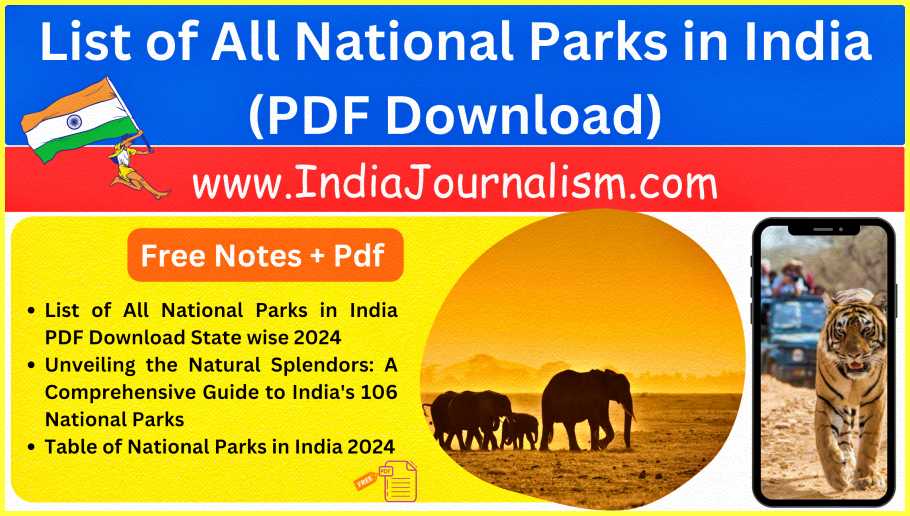List of All National Parks in India PDF Download State wise 2024
Today we will share the List of All National Parks in India PDF Download State wise and you can download this page as a Pdf in All Languages in 1 click (ICON: see on your right Top side), just go to the end of this page you will get a PDF Download Button and this PDF is very Important for your Upcoming Exams like UPSC, SSC, BANK, etc.
- India, a land of rich biodiversity and diverse ecosystems, is home to an impressive array of wildlife and natural wonders. The country’s commitment to preserving its natural heritage is evident in the establishment of numerous national parks, which protect and showcase its unique flora and fauna. From the majestic Himalayas in the north to the lush forests of the Western Ghats in the south, India’s national parks offer a glimpse into the country’s incredible natural beauty. In this article, we will take you on a virtual tour of all the national parks in India.
Also read: SlideSharePPT
National Parks in India 2024
India, in the year 2024, stands as a nation blessed with an incredible diversity of species, both flora and fauna. The country boasts a rich tapestry of plant and animal life, making it a biodiversity hotspot on the global map. One of the key facets of India’s natural beauty lies in its national parks, which serve as sanctuaries for this diverse wildlife.
- The Indo-Himalayan eco-zone, a significant region in India, showcases a remarkable variety of species. Approximately 6.2 percent of the world’s reptiles, 7.6 percent of mammals, 6.0 percent of flowering plants, and 12.6 percent of bird species find their home within this eco-zone. This staggering biodiversity is a testament to India’s unique ecological landscape.
- India’s national parks are a testament to its commitment to preserving this rich natural heritage. These protected areas span a wide range of ecosystems, from the towering coniferous forests of the Himalayan region to the lush tropical rainforests in Northeast India, the Western Ghats, and the country’s tropical regions. Each of these parks serves as a haven for specific species, allowing them to thrive in their natural habitats.
As we step into 2024, India continues to be a beacon of conservation, emphasizing the importance of these national parks in safeguarding our planet’s precious biodiversity. These parks not only preserve the unique and varied species found within their boundaries but also offer an opportunity for people to connect with nature, fostering a sense of responsibility towards our environment. Through these efforts, India stands as a shining example of how a nation can protect its natural heritage while embracing the wonders of its diverse flora and fauna.
What is National Park?
A National Park serves as a sanctuary meticulously safeguarded to enhance wildlife and promote biodiversity. Within these designated areas, any form of development, forestry, poaching, hunting, or grazing on agricultural land is strictly prohibited by law. To qualify as a national park, a location must possess significant ecological, geomorphologic, and natural value, as determined by the Indian government. India boasts a wealth of wildlife, boasting over 100 internationally acclaimed national parks. These parks have been classified by the International Union for the Conservation of Nature (IUCN) as the second category of protected areas. Every state in India is home to at least one national park, each showcasing the vibrant indigenous flora and fauna unique to its region.
- National parks are protected areas designated by the government for the conservation and protection of natural resources, including wildlife, flora, and landscapes. These areas are crucial for preserving the rich biodiversity of a region and promoting ecotourism. India’s national parks are managed by the National Tiger Conservation Authority and the respective state forest departments.
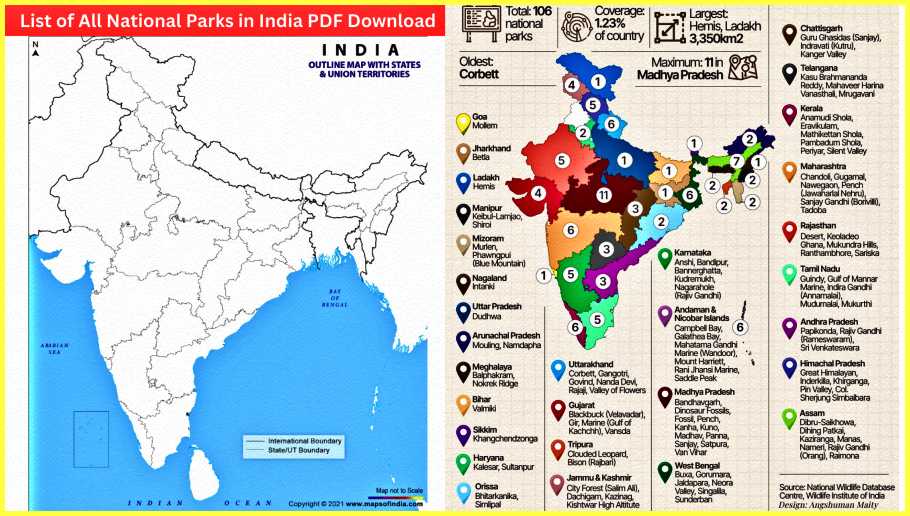
List of All National Parks in India 2024
| S.No. | (State + No. of N.P) | National Parks in India | Year | Area
(km2) |
| 1 | Andaman & Nicobar Islands
(9 National Parks) |
Campbell Bay National Park | 1992 | 426.23 |
| 2 | Galathea Bay National Park | 1992 | 110 | |
| 3 | Mahatama Gandhi Marine (Wandoor) NP | 1983 | 281.5 | |
| 4 | Middle Button Island National Park | 1987 | 0.44 | |
| 5 | Mount Harriett National Park | 1987 | 46.62 | |
| 6 | North Button Island National Park | 1987 | 0.44 | |
| 7 | Rani Jhansi Marine National Park | 1996 | 256.14 | |
| 8 | Saddle Peak National Park | 1987 | 32.54 | |
| 9 | South Button Island National Park | 1987 | 0.03 | |
| 10 | Andhra Pradesh
(3 National Parks) |
Papikonda National Park | 2008 | 1013 |
| 11 | Rajiv Gandhi (Rameswaram) National Park | 2005 | 2.4 | |
| 12 | Sri Venkateswara National Park | 1989 | 353.6 | |
| 13 | Arunachal Pradesh
(2 National Parks) |
Mouling National Park | 1986 | 483 |
| 14 | Namdapha National Park | 1983 | 1808 | |
| 15 | Assam
(7 National Parks) |
Dibru-Saikhowa National Park | 1999 | 340 |
| 16 | Kaziranga National Park | 1974 | 859 | |
| 17 | Manas National Park | 1990 | 500 | |
| 18 | Nameri National Park | 1998 | 200 | |
| 19 | Orang National Park | 1999 | 78.81 | |
| 20 | Raimona National Park | 2021 | 422 | |
| 21 | Dihing Patkai National Park | 2021 | 234 | |
| 22 | Bihar
(1 National Parks) |
Valmiki National Park | 1989 | 335.65 |
| 23 | Chhattisgarh
(3 National Parks) |
Guru Ghasidas (Sanjay) National Park | 1981 | 1440.7 |
| 24 | Indravati (Kutru) National Park | 1982 | 1258.4 | |
| 25 | Kanger Valley National Park | 1982 | 200 | |
| 26 | Goa
(1 National Parks) |
Mollem National Park | 1992 | 107 |
| 27 | Gujarat
(4 National Parks) |
Vansda National Park | 1979 | 23.99 |
| 28 | Blackbuck (Velavadar) National Park | 1976 | 34.53 | |
| 29 | Gir National Park | 1975 | 258.71 | |
| 30 | Marine (Gulf of Kachchh) National Park | 1982 | 162.89 | |
| 31 | Haryana
(2 National Parks) |
Kalesar National Park | 2003 | 46.82 |
| 32 | Sultanpur National Park | 1989 | 1.43 | |
| 33 | Himachal Pradesh
(5 National Parks) |
Great Himalayan National Park | 1984 | 754.4 |
| 34 | Inderkilla National Park | 2010 | 104 | |
| 35 | Khirganga National Park | 2010 | 710 | |
| 36 | Pin Valley National Park | 1987 | 675 | |
| 37 | Simbalbara National Park | 2010 | 27.88 | |
| 38 | UT of Jammu & Kashmir
(3 National Parks) UT of Ladakh (1 National Parks) |
City Forest (Salim Ali) National Park (J&K) | 1992 | 9 |
| 39 | Dachigam National Park (J&K) | 1981 | 141 | |
| 40 | Hemis National Park (Ladakh) | 1981 | 3350 | |
| 41 | Kishtwar National Park (J&K) | 1981 | 425 | |
| 42 | Jharkhand
(1 National Parks) |
Betla National Park | 1986 | 226.33 |
| 43 | Karnataka
(5 National Parks) |
Anshi National Park | 1987 | 417.34 |
| 44 | Bandipur National Park | 1974 | 874.2 | |
| 45 | Bannerghatta National Park | 1974 | 260.51 | |
| 46 | Kudremukh National Park | 1987 | 600.32 | |
| 47 | Nagarhole National Park (Rajiv Gandhi) | 1988 | 643.39 | |
| 48 | Kerala
(6 National Parks) |
Anamudi Shola National Park | 2003 | 7.5 |
| 49 | Eravikulam National Park | 1978 | 97 | |
| 50 | Mathikettan Shola National Park | 2003 | 12.82 | |
| 51 | Pambadum Shola National Park | 2003 | 1.318 | |
| 52 | Periyar National Park | 1982 | 350 | |
| 53 | Silent Valley National Park | 1984 | 89.52 | |
| 54 | Madhya Pradesh
(10 National Parks) |
Bandhavgarh National Park | 1968 | 448.85 |
| 55 | Dinosaur Fossils National Park | 2011 | 0.8974 | |
| 56 | Fossil National Park | 1983 | 0.27 | |
| 57 | Pench National Park | 1975 | 292.85 | |
| 58 | Kanha National Park | 1955 | 940 | |
| 59 | Madhav National Park | 1959 | 375.22 | |
| 60 | Panna National Park | 1981 | 542.67 | |
| 61 | Sanjay National Park | 1981 | 466.88 | |
| 62 | Satpura National Park | 1981 | 585.17 | |
| 63 | Van Vihar National Park | 1979 | 4.45 | |
| 64 | Maharashtra
(6 National Parks) |
Chandoli National Park | 2004 | 317.67 |
| 65 | Gugamal National Park | 1975 | 361.28 | |
| 66 | Nawegaon National Park | 1975 | 133.88 | |
| 67 | Pench (Jawaharlal Nehru) National Park | 1975 | 257.26 | |
| 68 | Sanjay Gandhi National Park (Borivali) | 1983 | 86.96 | |
| 69 | Tadoba National Park | 1955 | 116.55 | |
| 70 | Manipur
(1 National Parks) |
Keibul-Lamjao National Park | 1977 | 40 |
| 71 | Meghalaya
(2 National Parks) |
Balphakram National Park | 1985 | 220 |
| 72 | Nokrek Ridge National Park | 1986 | 47.48 | |
| 73 | Mizoram
(2 National Parks) |
Murlen National Park | 1991 | 100 |
| 74 | Phawngpui Blue Mountain National Park | 1992 | 50 | |
| 75 | Nagaland
(1 National Parks) |
Intanki National Park | 1993 | 202.02 |
| 76 | Odisha
(2 National Parks) |
Bhitarkanika National Park | 1988 | 145 |
| 77 | Simlipal National Park | 1980 | 845.7 | |
| 78 | Rajasthan
(5 National Parks) |
Desert National Park | 1992 | 3162 |
| 79 | Keoladeo Ghana National Park | 1981 | 28.73 | |
| 80 | Mukundra Hills National Park | 2006 | 200.54 | |
| 81 | Ranthambore National Park | 1980 | 282 | |
| 82 | Sariska National Park | 1992 | 273.8 | |
| 83 | Sikkim
(1 National Parks) |
Khangchendzonga National Park | 1977 | 1784 |
| 84 | Tamil Nadu
(5 National Parks) |
Guindy National Park | 1976 | 2.82 |
| 85 | Gulf of Mannar Marine National Park | 1980 | 6.23 | |
| 86 | Indira Gandhi (Annamalai) National Park | 1989 | 117.1 | |
| 87 | Mudumalai National Park | 1990 | 103.23 | |
| 88 | Mukurthi National Park | 1990 | 78.46 | |
| 89 | Telangana
(3 National Parks) |
Kasu Brahmananda Reddy National Park | 1994 | 1.43 |
| 90 | Mahaveer Harina Vanasthali National Park | 1994 | 14.59 | |
| 91 | Mrugavani National Park | 1994 | 3.6 | |
| 92 | Tripura
(2 National Parks) |
Clouded Leopard National Park | 2007 | 5.08 |
| 93 | Bison (Rajbari) National Park | 2007 | 31.63 | |
| 94 | Uttar Pradesh
(1 National Parks) |
Dudhwa National Park | 1977 | 490 |
| 95 | Uttarakhand
(6 National Parks) |
Jim Corbett National Park | 1936 | 520.82 |
| 96 | Gangotri National Park | 1989 | 2390.02 | |
| 97 | Govind National Park | 1990 | 472.08 | |
| 98 | Nanda Devi National Park | 1982 | 624.6 | |
| 99 | Rajaji National Park | 1983 | 820 | |
| 100 | Valley of Flowers National Park | 1982 | 87.5 | |
| 101 | West Bengal
(6 National Parks) |
Buxa National Park | 1992 | 117.1 |
| 102 | Gorumara National Park | 1992 | 79.45 | |
| 103 | Jaldapara National Park | 2014 | 216.51 | |
| 104 | Neora Valley National Park | 1986 | 159.89 | |
| 105 | Singalila National Park | 1986 | 78.6 | |
| 106 | Sunderban National Park | 1984 | 1330.1 |
Unveiling the Natural Splendors: A Comprehensive Guide to India’s 106 National Parks
India, a land blessed with diverse ecosystems and captivating wildlife, boasts 106 National Parks, each a treasure trove of natural wonders. From the towering peaks of the Himalayas to the sun-kissed shores of the Andaman & Nicobar Islands, these parks narrate tales of conservation, biodiversity, and the harmonious coexistence of humans and nature. Let’s embark on a virtual journey through the heart of India’s wilderness, exploring its 106 National Parks in all their glory.
1. Andaman & Nicobar Islands:
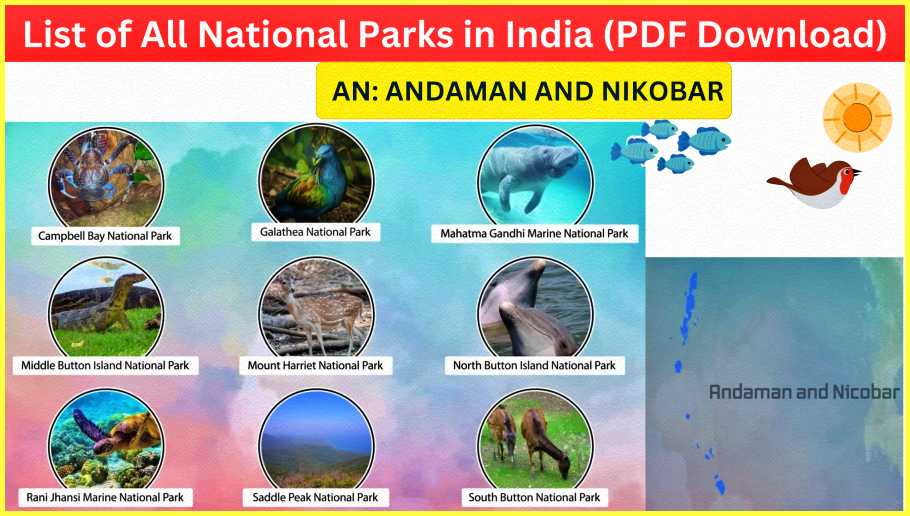
Here are the List of Andaman & Nicobar Islands National Parks:
- Campbell Bay National Park (1992): Encompassing 426.23 sq km, this park is a sanctuary for unique flora and fauna in the southernmost part of the Andaman Islands.
- Galathea Bay National Park (1992): Spanning 110 sq km, it is renowned for its vibrant coral reefs and marine biodiversity.
- Mahatama Gandhi Marine (Wandoor) NP (1983): Spread over 281.5 sq km, it offers a mesmerizing glimpse into marine life, making it a haven for underwater enthusiasts.
- Middle Button Island National Park (1987): Though small at 0.44 sq km, it plays a vital role in preserving island ecosystems.
- Mount Harriett National Park (1987): Covering 46.62 sq km, this park offers panoramic views and diverse wildlife.
- North Button Island National Park (1987): With an area of 0.44 sq km, it’s a haven for various bird species.
- Rani Jhansi Marine National Park (1996): Encompassing 256.14 sq km, it boasts rich coral reefs and diverse marine life.
- Saddle Peak National Park (1987): Covering 32.54 sq km, it is adorned with dense forests and unique avian species.
- South Button Island National Park (1987): Though small at 0.03 sq km, it’s significant for marine conservation efforts.
2. Andhra Pradesh:
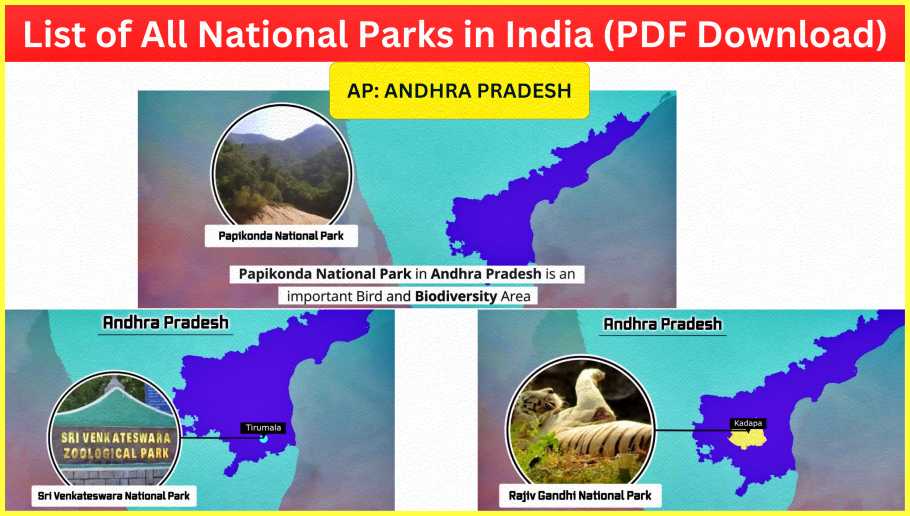
- Papikonda National Park (2008): Extending over 1013 sq km, this park along the Godavari River is home to tigers, leopards, and elephants.
- Rajiv Gandhi (Rameswaram) National Park (2005): Covering 2.4 sq km, it shelters a variety of avian species, making it a paradise for birdwatchers.
- Sri Venkateswara National Park (1989): Spanning 353.6 sq km, it showcases diverse flora and fauna, adding to the state’s natural heritage.
3. Arunachal Pradesh:
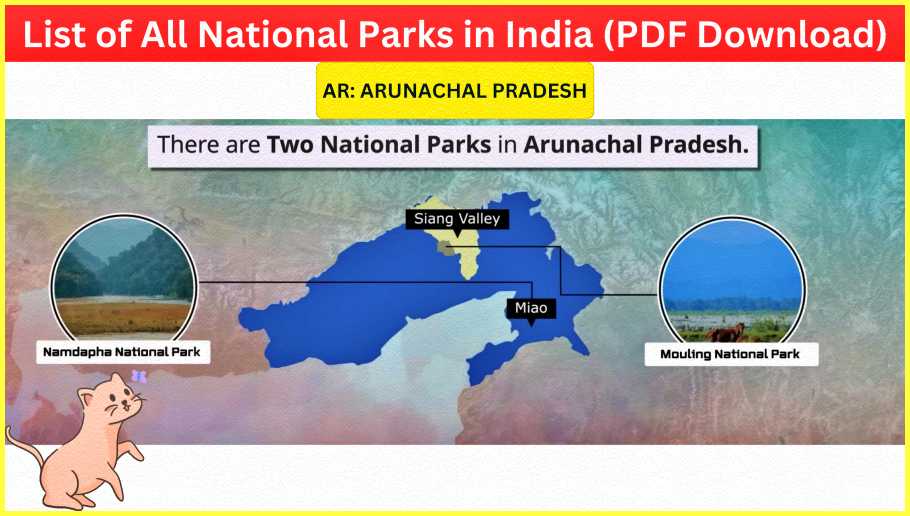
- Mouling National Park (1986): Extending over 483 sq km, it’s a dense forest teeming with unique biodiversity.
- Namdapha National Park (1983): Encompassing a vast 1808 sq km, it’s one of India’s largest parks, offering a haven for diverse wildlife, including the elusive snow leopard.
4. Assam:
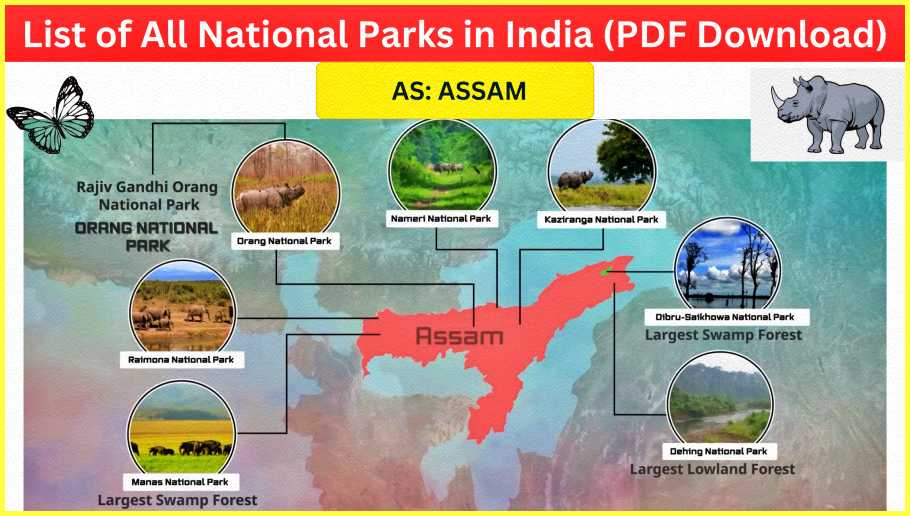
- Dibru-Saikhowa National Park (1999): Covering 340 sq km, it’s a wetland paradise hosting rare and endangered species.
- Kaziranga National Park (1974): Spanning 859 sq km, it’s a UNESCO World Heritage Site and a stronghold for the Indian one-horned rhinoceros.
- Manas National Park (1990): Encompassing 500 sq km, it’s not just a park but a UNESCO World Heritage Site, celebrated for its diverse flora and fauna.
- Nameri National Park (1998): Covering 200 sq km, it’s a pristine forest area with the Jia Bhoroli River meandering through, offering a picturesque landscape.
- Orang National Park (1999): Encompassing 78.81 sq km, it’s a vital wetland habitat for various wildlife species.
- Raimona National Park (2021): A newly established park, covering 422 sq km, it promises exciting explorations and conservation efforts.
- Dihing Patkai National Park (2021): Spanning 234 sq km, it’s a biodiversity hotspot, preserving the unique flora and fauna of the region.
5. Bihar:

- Valmiki National Park (1989): Extending over 335.65 sq km, it’s known for its lush forests and diverse wildlife.
6. Chhattisgarh:
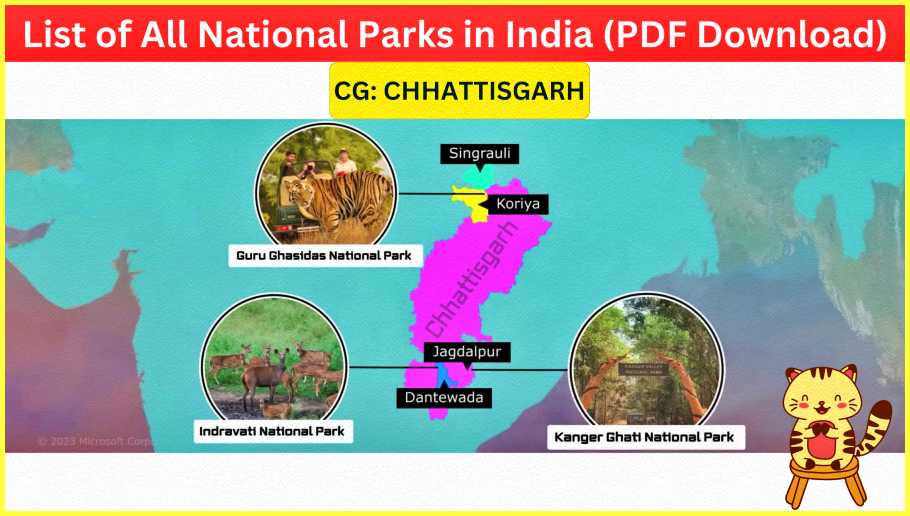
- Guru Ghasidas (Sanjay) National Park (1981): Covering 1440.7 sq km, it’s a haven for biodiversity, housing a variety of plant and animal species.
- Indravati (Kutru) National Park (1982): Spanning 1258.4 sq km, it’s a landscape of pristine beauty, rich in flora and fauna.
- Kanger Valley National Park (1982): Covering 200 sq km, it’s a wilderness gem, offering an immersive experience in nature’s lap.
7. Goa:
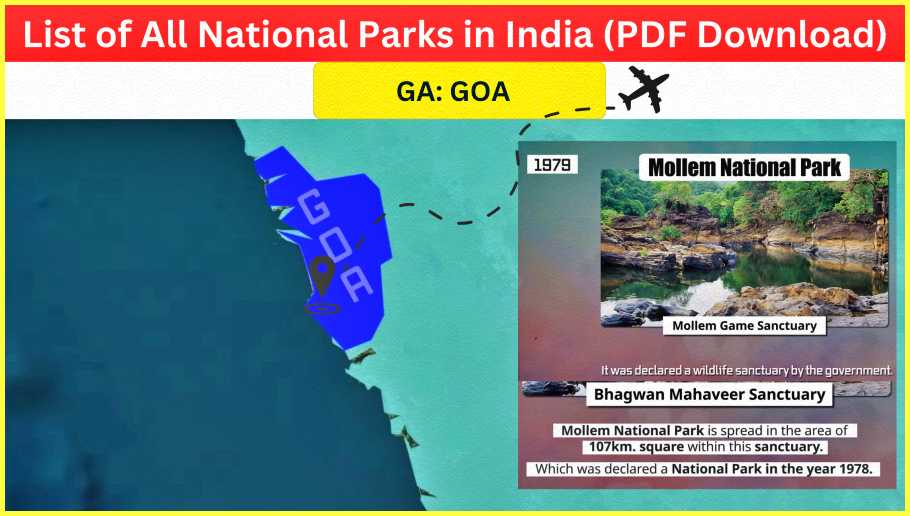
- Mollem National Park (1992): Extending over 107 sq km, it’s a sanctuary for Goa’s unique biodiversity, including the iconic Dudhsagar Waterfalls.
8. Gujarat:

- Vansda National Park (1979): Spanning 23.99 sq km, it’s a compact forest area with rich biodiversity.
- Blackbuck (Velavadar) National Park (1976): Covering 34.53 sq km, it’s a crucial habitat for the elegant Indian blackbuck.
- Gir National Park (1975): Encompassing 258.71 sq km, it’s the last abode of the Asiatic lions, making it a symbol of successful conservation efforts.
- Marine (Gulf of Kachchh) National Park (1982): Covering 162.89 sq km, it’s a marine wonderland, teeming with diverse aquatic life and vibrant coral reefs.
9. Haryana:
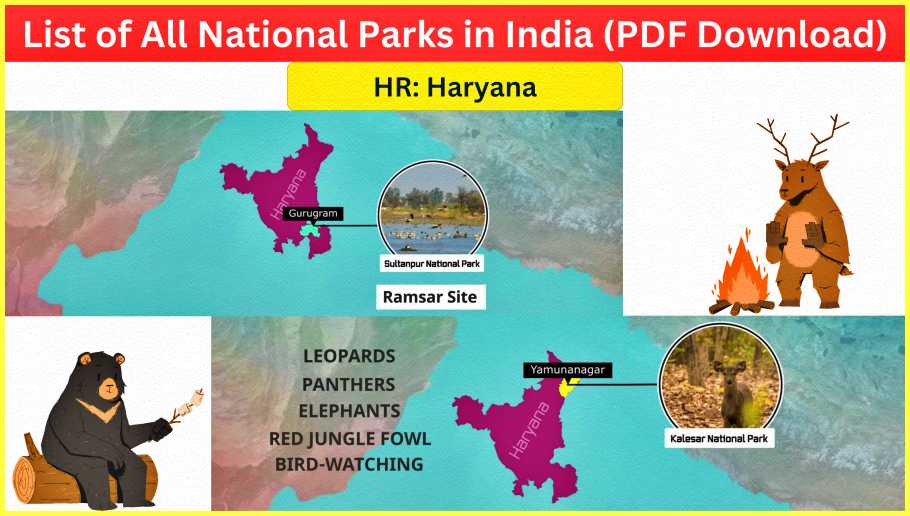
- Kalesar National Park (2003): Extending over 46.82 sq km, it’s a verdant forest offering a sanctuary for various wildlife species.
- Sultanpur National Park (1989): Covering 1.43 sq km, it’s a vital bird habitat, attracting migratory species during different seasons.
10. Himachal Pradesh:
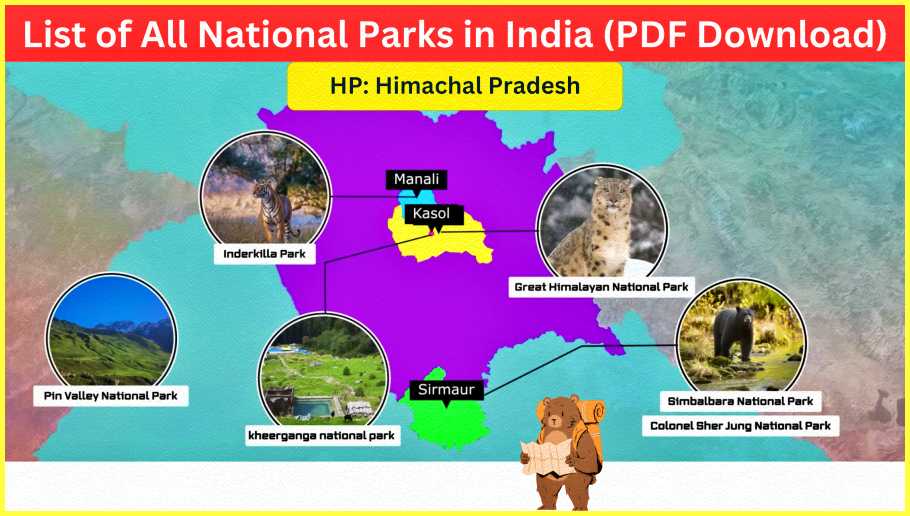
- Great Himalayan National Park (1984): Spanning 754.4 sq km, it’s a paradise for nature lovers, showcasing the grandeur of the Himalayas and the richness of its biodiversity.
- Inderkilla National Park (2010): Covering 104 sq km, it’s a haven for diverse flora and fauna, providing a pristine environment for their growth.
- Khirganga National Park (2010): Extending over 710 sq km, it’s a testament to the breathtaking beauty of the Himalayan region.
- Pin Valley National Park (1987): Spanning 675 sq km, it’s a sanctuary for the elusive snow leopards and unique high-altitude ecosystems.
- Simbalbara National Park (2010): Covering 27.88 sq km, it’s a dense forest area, home to a variety of wildlife species.
11. Jammu & Kashmir (UT) and Ladakh (UT):
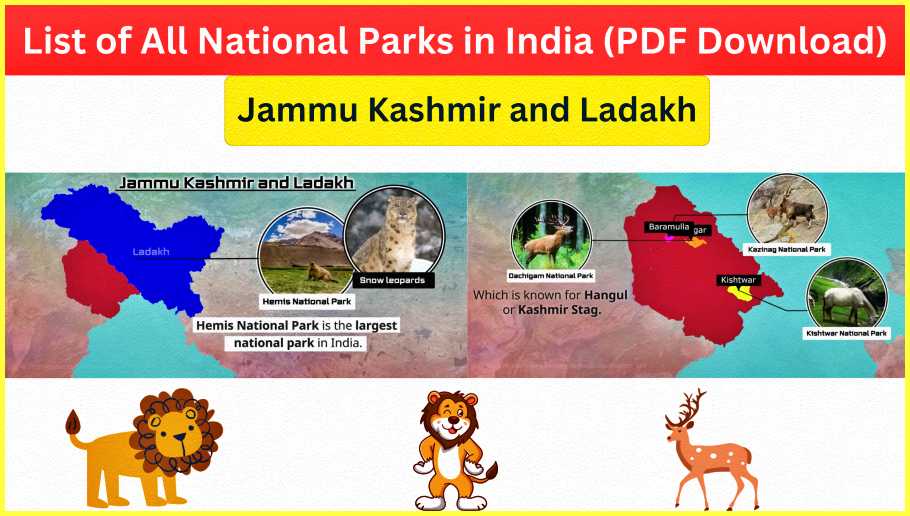
- City Forest (Salim Ali) National Park (J&K) (1992): Spanning 9 sq km, it’s a green oasis amidst the urban sprawl of Srinagar, offering a breath of fresh air for the city’s residents.
- Dachigam National Park (J&K) (1981): Covering 141 sq km, it’s renowned for its Hangul population, an endangered species of deer found only in this region.
- Hemis National Park (Ladakh) (1981): One of India’s largest National Parks, covering 3350 sq km, it’s a haven for snow leopards, making it a prime destination for wildlife enthusiasts.
- Kishtwar National Park (J&K) (1981): Spanning 425 sq km, it’s a paradise for nature lovers, with diverse landscapes and rich biodiversity.
12. Jharkhand:
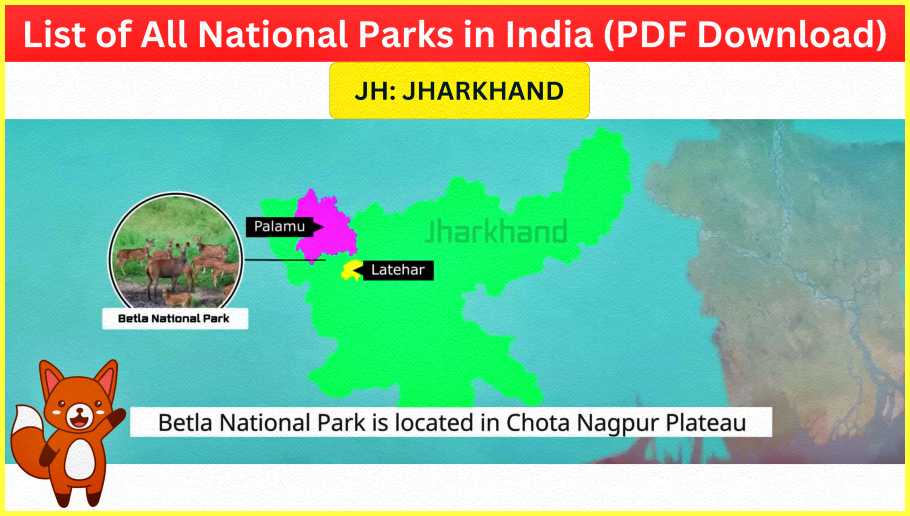
- Betla National Park (1986): Covering 226.33 sq km, it’s a lush green expanse, home to a variety of wildlife species.
13. Karnataka:
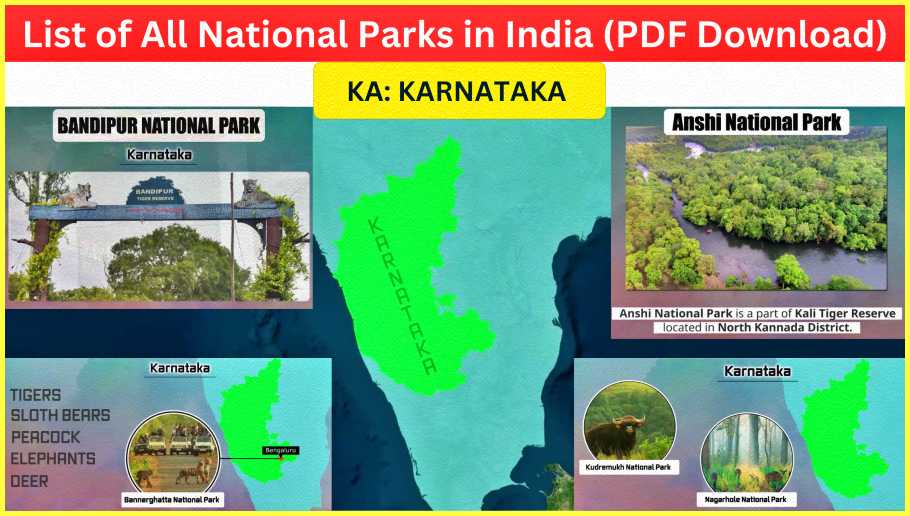
- Anshi National Park (1987): Spanning 417.34 sq km, it’s a biodiversity hotspot with dense evergreen and semi-evergreen forests.
- Bandipur National Park (1974): Encompassing 874.2 sq km, it’s renowned for its tiger population and is an essential link in the Nilgiri Biosphere Reserve.
- Bannerghatta National Park (1974): Covering 260.51 sq km, it’s a popular destination for wildlife enthusiasts, offering a chance to witness animals in their natural habitat.
- Kudremukh National Park (1987): Extending over 600.32 sq km, it’s a picturesque landscape of rolling hills, grasslands, and dense forests.
- Nagarhole National Park (Rajiv Gandhi) (1988): Spanning 643.39 sq km, it’s a vital habitat for tigers, Indian bison, and various bird species.
14. Kerala:
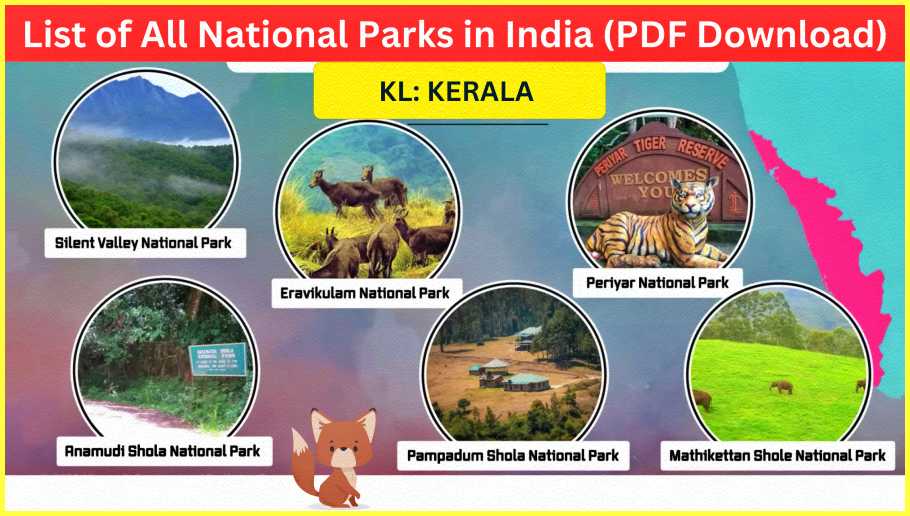
- Anamudi Shola National Park (2003): Covering 7.5 sq km, it’s known for its unique shola-grassland ecosystems, harboring a variety of wildlife.
- Eravikulam National Park (1978): Spanning 97 sq km, it’s famous for the Nilgiri tahr, an endangered species of mountain goat, found in its steep hills.
- Mathikettan Shola National Park (2003): Extending over 12.82 sq km, it’s a lush forest area, teeming with diverse flora and fauna.
- Pambadum Shola National Park (2003): Spanning 1.318 sq km, it’s a critical habitat for various endangered species, making it a conservation priority.
- Periyar National Park (1982): Covering 350 sq km, it’s a vibrant ecosystem centered around the scenic Periyar Lake, home to elephants, tigers, and a rich avian population.
- Silent Valley National Park (1984): Encompassing 89.52 sq km, it’s a pristine tropical evergreen forest, housing rare and endemic species, making it a biodiversity hotspot.
15. Madhya Pradesh:
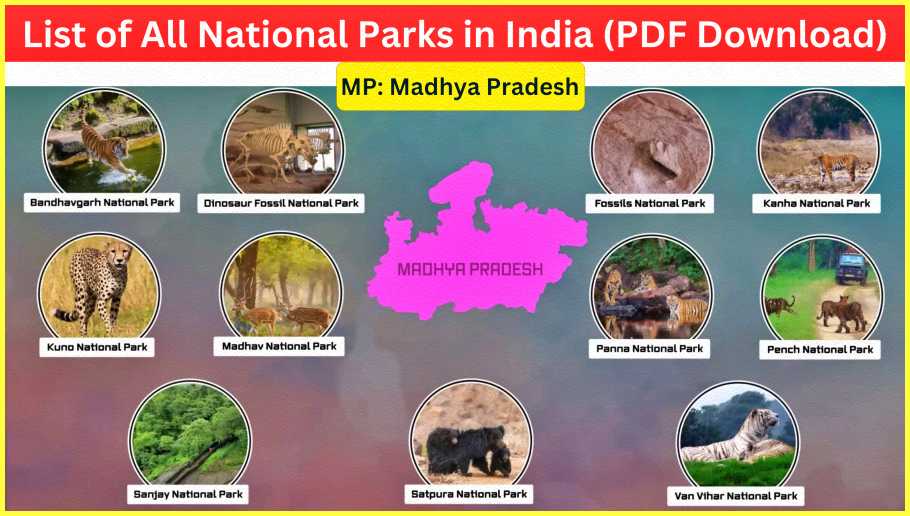
- Bandhavgarh National Park (1968): Spanning 448.85 sq km, it’s renowned for its high tiger density and the ancient Bandhavgarh Fort, adding historical significance to its natural beauty.
- Dinosaur Fossils National Park (2011): Covering 0.8974 sq km, it’s a unique park with a rich repository of dinosaur fossils, offering a glimpse into the Earth’s ancient past.
- Fossil National Park (1983): Spanning 0.27 sq km, it’s a geological marvel, preserving ancient plant fossils, providing valuable insights into the Earth’s prehistoric flora.
- Pench National Park (1975): Extending over 292.85 sq km, it’s characterized by the picturesque Pench River, flowing through the park, sustaining its rich biodiversity.
- Kanha National Park (1955): One of India’s largest National Parks, covering 940 sq km, it’s celebrated for its tiger population and diverse ecosystems.
- Madhav National Park (1959): Spanning 375.22 sq km, it’s a scenic wonder, offering a sanctuary for leopards, sloth bears, and a plethora of bird species.
- Panna National Park (1981): Covering 542.67 sq km, it’s known for its tigers and the picturesque landscapes surrounding the Ken River.
- Sanjay National Park (1981): Extending over 466.88 sq km, it’s a biodiversity hotspot, harboring various flora and fauna, including the critically endangered vultures, highlighting the park’s ecological importance.
- Satpura National Park (1981): Covering 585.17 sq km, it’s a marvel of nature, showcasing unique landscapes and diverse wildlife, making it a must-visit for nature enthusiasts.
- Van Vihar National Park (1979): Spanning 4.45 sq km, this city-based park in Bhopal provides an opportunity for urban dwellers to connect with nature, offering a glimpse into India’s wildlife within an urban setting.
16. Maharashtra:

- Chandoli National Park (2004): Covering 317.67 sq km, it’s a verdant expanse of dense forests and the majestic Chandoli Dam, creating a picturesque setting for both flora and fauna.
- Gugamal National Park (1975): Spanning 361.28 sq km, it’s famed for its teak forests and diverse wildlife, making it a haven for nature lovers and wildlife photographers.
- Nawegaon National Park (1975): Extending over 133.88 sq km, it’s a paradise for birdwatchers, offering glimpses of rare avian species in their natural habitat.
- Pench (Jawaharlal Nehru) National Park (1975): Covering 257.26 sq km, it’s renowned for its vibrant tiger population and the tranquil Pench River, enhancing the park’s scenic beauty.
- Sanjay Gandhi National Park (Borivali) (1983): Spanning 86.96 sq km, it’s an oasis of wilderness in the bustling city of Mumbai. Home to diverse flora and fauna, it provides a unique opportunity for urban dwellers to experience nature up close.
- Tadoba National Park (1955): Extending over 116.55 sq km, it’s one of India’s premier tiger reserves, drawing wildlife enthusiasts from around the world. The park’s rich biodiversity and successful conservation efforts make it a vital asset in India’s natural heritage.
17. Manipur:
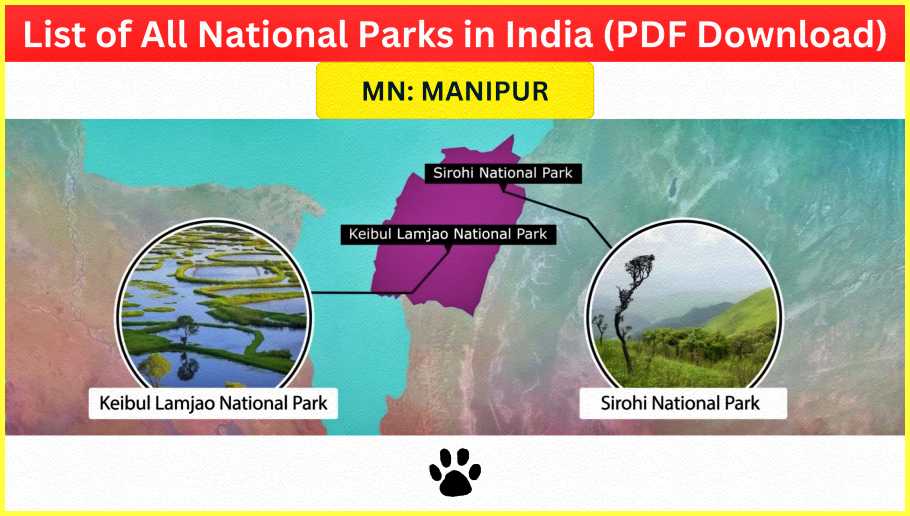
- Keibul-Lamjao National Park (1977): Covering 40 sq km, it’s the world’s only floating National Park, located on the Loktak Lake. Home to the endangered Sangai deer, this park showcases the delicate balance between aquatic and terrestrial ecosystems.
18. Meghalaya:
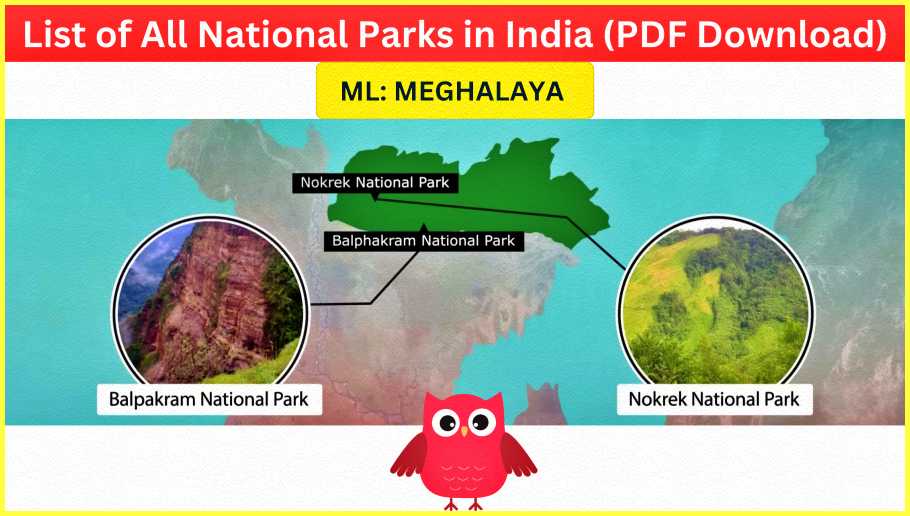
- Balphakram National Park (1985): Spanning 220 sq km, it’s a land of dramatic landscapes and rich biodiversity. Elephants roam freely, and red pandas find sanctuary in its dense forests, making it a haven for wildlife enthusiasts and researchers.
- Nokrek Ridge National Park (1986): Covering 47.48 sq km, it’s famous for harboring the Citrus indica, a rare and endangered citrus species. The park’s unique flora and fauna contribute significantly to Meghalaya’s ecological diversity.
19. Mizoram:

- Murlen National Park (1991): Extending over 100 sq km, it’s a treasure trove of biodiversity. Rare and endemic species find refuge in its dense forests, making it a vital conservation area for Mizoram.
- Phawngpui Blue Mountain National Park (1992): Spanning 50 sq km, it’s the highest peak in Mizoram and a biodiversity hotspot. The park’s unique ecology and stunning landscapes attract nature enthusiasts and researchers alike.
20. Nagaland:
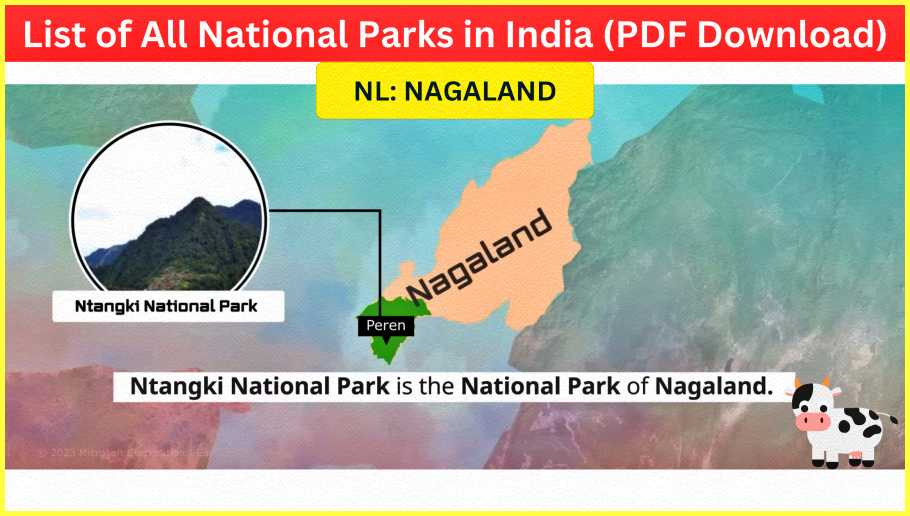
- Intanki National Park (1993): Covering 202.02 sq km, it’s a haven for flora and fauna. The park’s diverse landscapes, including hills, forests, and grasslands, provide a sanctuary for various wildlife species.
21. Odisha:
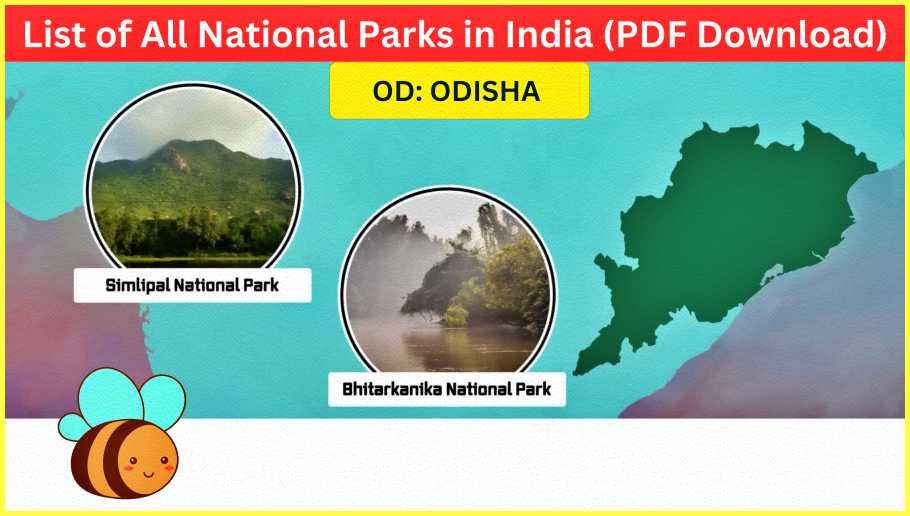
- Bhitarkanika National Park (1998): Encompassing 145 sq km, it’s renowned for its mangrove forests and estuarine crocodiles. The park’s unique ecosystem supports a wide array of wildlife, including various bird species and saltwater crocodiles.
- Simlipal National Park (1980): Spanning 2750 sq km, it’s a UNESCO Biosphere Reserve and a haven for Bengal tigers. The park’s diverse flora and fauna, coupled with its scenic beauty, make it a prime destination for eco-tourism.
- Nandankanan Zoological Park (1960): Covering 4.37 sq km, this zoo also functions as a botanical garden. It’s home to a variety of animal species, including the rare white tiger, and serves as an educational hub for wildlife conservation.
22. Punjab:
- Bir Moti Bagh Wildlife Sanctuary (2005): Extending over 7.69 sq km, it’s a green oasis in Punjab. The sanctuary’s lush vegetation provides a habitat for various bird species, making it a popular spot for birdwatching and nature enthusiasts.
23. Rajasthan:
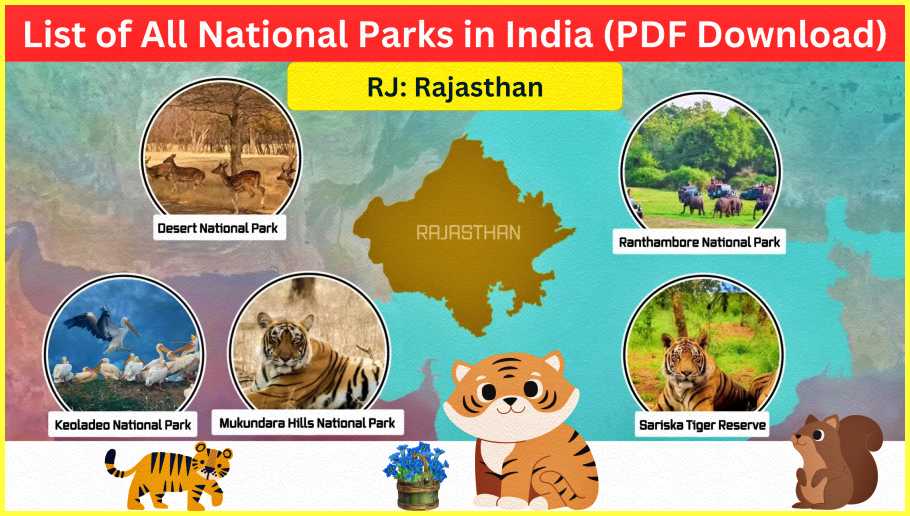
- Darrah National Park (2004): Spanning 250 sq km, it’s a haven for wildlife enthusiasts. The park’s rugged terrain and diverse flora and fauna make it an ideal destination for nature lovers and photographers.
- Desert National Park (1980): Covering 3162 sq km, it’s a unique ecosystem in the Thar Desert. The park’s sand dunes and diverse wildlife, including the Great Indian Bustard, attract researchers and wildlife enthusiasts from around the world.
- Keoladeo Ghana National Park (1981): Spanning 28.73 sq km, it’s a UNESCO World Heritage Site and a paradise for birdwatchers. The park’s wetlands provide a vital habitat for migratory birds, making it a hotspot for avian biodiversity.
24. Sikkim:
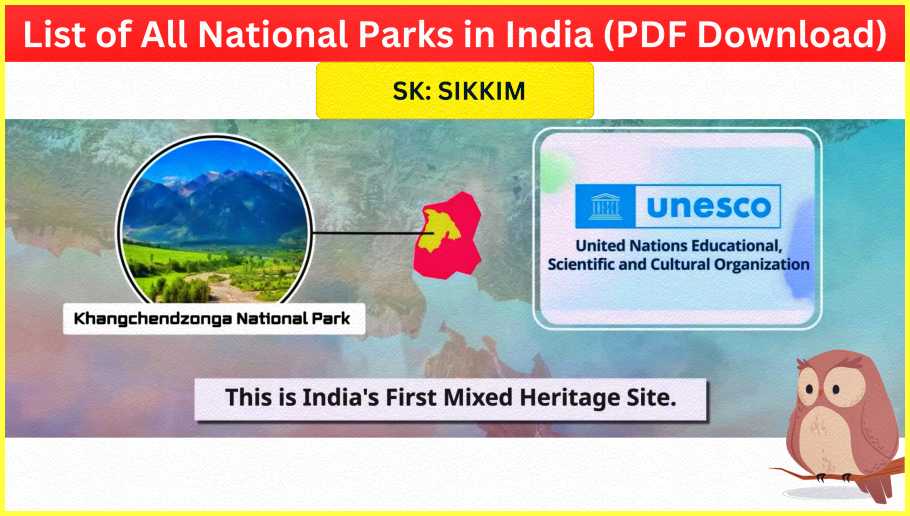
- Barsey Rhododendron Sanctuary (1994): Covering 104 sq km, it’s a floral paradise, especially during the rhododendron blooming season. The sanctuary’s vibrant flora and serene ambiance make it a must-visit for nature enthusiasts and botanists.
25. Tamil Nadu:
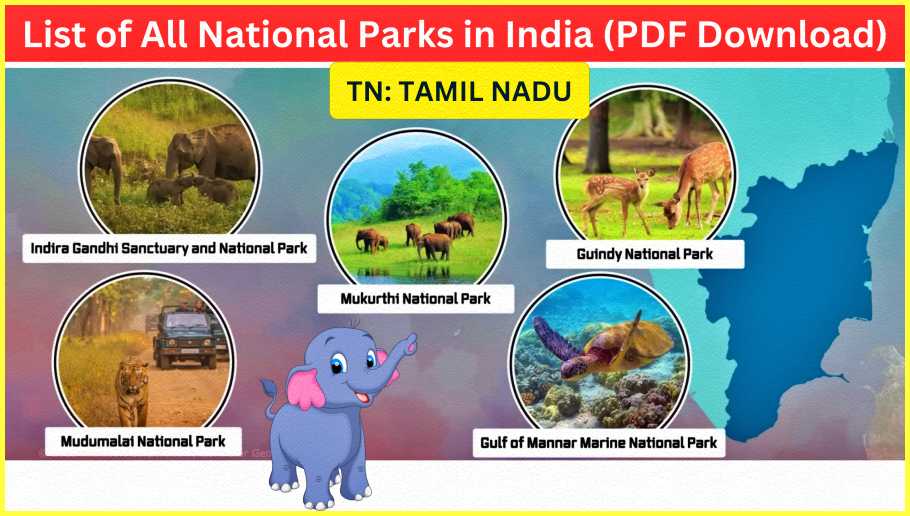
- Guindy National Park (1976): Spanning 2.82 sq km, it’s one of the smallest National Parks in India. Located in the heart of Chennai, it’s a unique urban park, showcasing the region’s biodiversity and providing a green retreat for city dwellers.
- Gulf of Mannar Marine National Park (1986): Encompassing 10,500 sq km, it’s a marine conservation area of great ecological significance. The park’s coral reefs, seagrass beds, and diverse marine life make it a hotspot for marine biodiversity and a popular destination for snorkeling and diving enthusiasts.
- Indira Gandhi Wildlife Sanctuary and National Park (1976): Covering 958 sq km, it’s nestled in the Western Ghats, showcasing the region’s rich biodiversity. The park’s diverse landscapes, waterfalls, and endemic species attract nature enthusiasts and researchers.
26. Telangana:
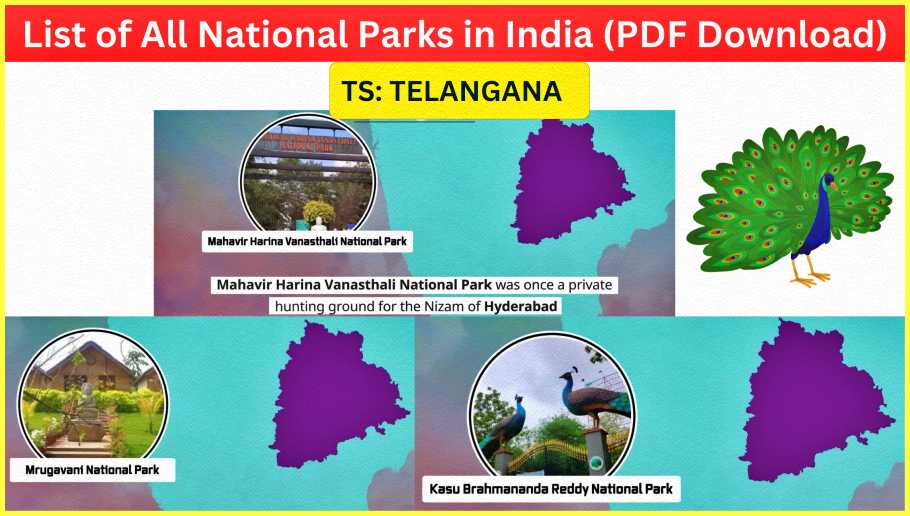
- Kasu Brahmananda Reddy National Park (1994): Spanning 1.6 sq km, it’s a serene oasis in the bustling city of Hyderabad. The park’s lush greenery, artificial lake, and diverse flora and fauna provide a refreshing experience for urban residents.
27. Tripura:

- Clouded Leopard National Park (2007): Covering 5.08 sq km, it’s dedicated to the conservation of the endangered clouded leopard. The park’s small size does not diminish its importance in safeguarding this elusive big cat species.
28. Uttar Pradesh:
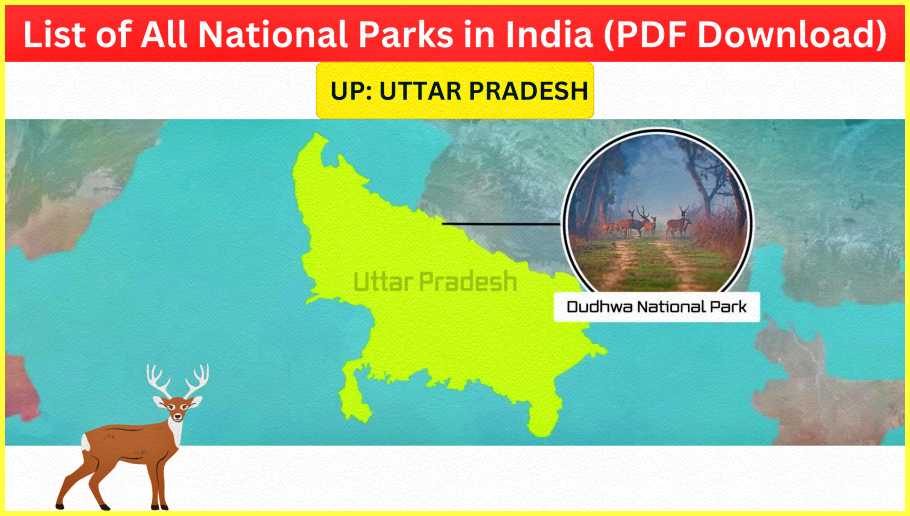
- Dudhwa National Park (1977): Extending over 490.3 sq km, it’s a haven for endangered species like the Indian rhinoceros. Dudhwa’s diverse ecosystems, including grasslands, swamps, and dense forests, support a wide variety of wildlife.
- Nawabganj Bird Sanctuary (1984): Covering 2.25 sq km, it’s a paradise for birdwatchers. The sanctuary’s wetlands attract migratory birds, making it a popular spot for avian enthusiasts.
- Pilibhit Tiger Reserve (2008): Spanning 732.84 sq km, it’s known for its high tiger density and lush forests. Pilibhit’s rich biodiversity and successful conservation efforts make it an essential tiger habitat in India.
29. Uttarakhand:
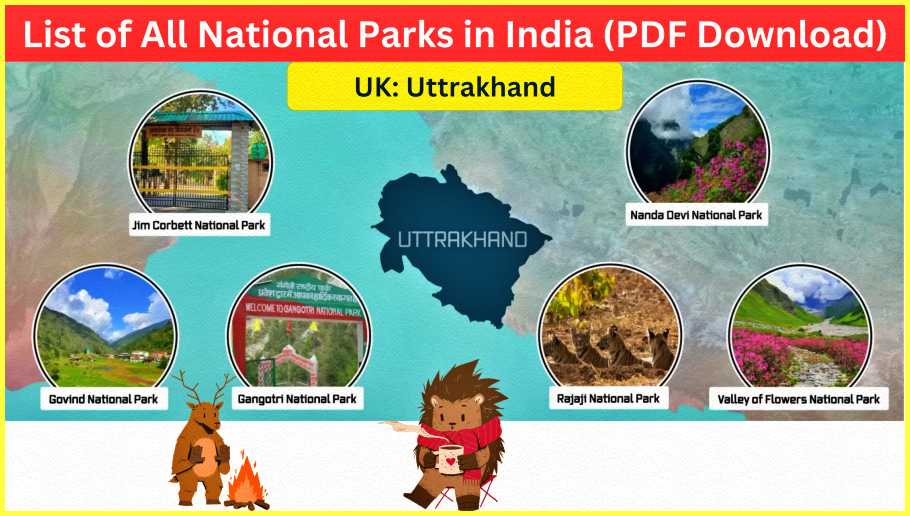
- Corbett National Park (1936): India’s oldest national park, covering 520.8 sq km, is famous for its Bengal tiger population and diverse wildlife. Corbett’s scenic beauty and varied landscapes, including grasslands, rivers, and hills, provide an enchanting experience for nature enthusiasts.
- Gangotri National Park (1989): Extending over 2390 sq km, it’s nestled in the Garhwal Himalayas and is the source of the Ganges River. Gangotri’s snow-capped peaks, glaciers, and alpine meadows attract trekkers, wildlife enthusiasts, and pilgrims.
- Govind Pashu Vihar Wildlife Sanctuary & National Park (1990): Spanning 472.08 sq km, it’s a biodiversity hotspot in the Western Himalayas. The sanctuary’s diverse flora and fauna, including the endangered snow leopard, make it a significant conservation area.
- Nanda Devi National Park and Valley of Flowers National Park (1982, 1988): Together forming a UNESCO World Heritage Site, they cover 712.65 sq km. Nanda Devi National Park’s rugged terrain and rare wildlife, coupled with Valley of Flowers’ vibrant floral displays, create a mesmerizing landscape, attracting nature enthusiasts and researchers.
30. West Bengal:

- Buxa Tiger Reserve (1983): Extending over 757.9 sq km, it’s known for its diverse wildlife, including tigers, leopards, and elephants. Buxa’s varied landscapes, ranging from dense forests to grasslands, provide habitats for numerous species.
- Gorumara National Park (1994): Spanning 79.45 sq km, it’s famed for its population of Indian rhinoceros. Gorumara’s lush forests and grasslands create a picturesque setting for wildlife enthusiasts.
- Neora Valley National Park (1986): Covering 159.89 sq km, it’s one of the last remaining pristine ecosystems in the Eastern Himalayas. Neora Valley’s dense forests, diverse fauna, and scenic beauty make it a paradise for nature lovers and researchers.
India’s 106 National Parks stand as testament to the country’s commitment to preserving its rich natural heritage. Each park, with its unique ecosystems and inhabitants, offers a glimpse into the wonders of the natural world. From the icy heights of the Himalayas to the sun-kissed beaches of the Andaman Islands, these parks beckon adventurers, wildlife enthusiasts, and researchers to explore, discover, and protect the incredible biodiversity that makes India truly unique.
Also Read:
- India At A Glance (Pdf Download)
- List of all prime minister of India 1947 to 2024 (PDF)
- List of all President of India (PDF)
- List of all Political Parties in India with Symbols (PDF)
- List of All 29 Indian States and Their Food Items (Cuisines)
- List of All Indian State Animals PDF
- List of All Social reformers of India (PDF Download)
- List of all IIT Colleges in India PDF Download (Packages)
- List of all NIT Colleges in India (PDF Download)
- List of all AIIMS Colleges in India PDF Download Rank & Fees
